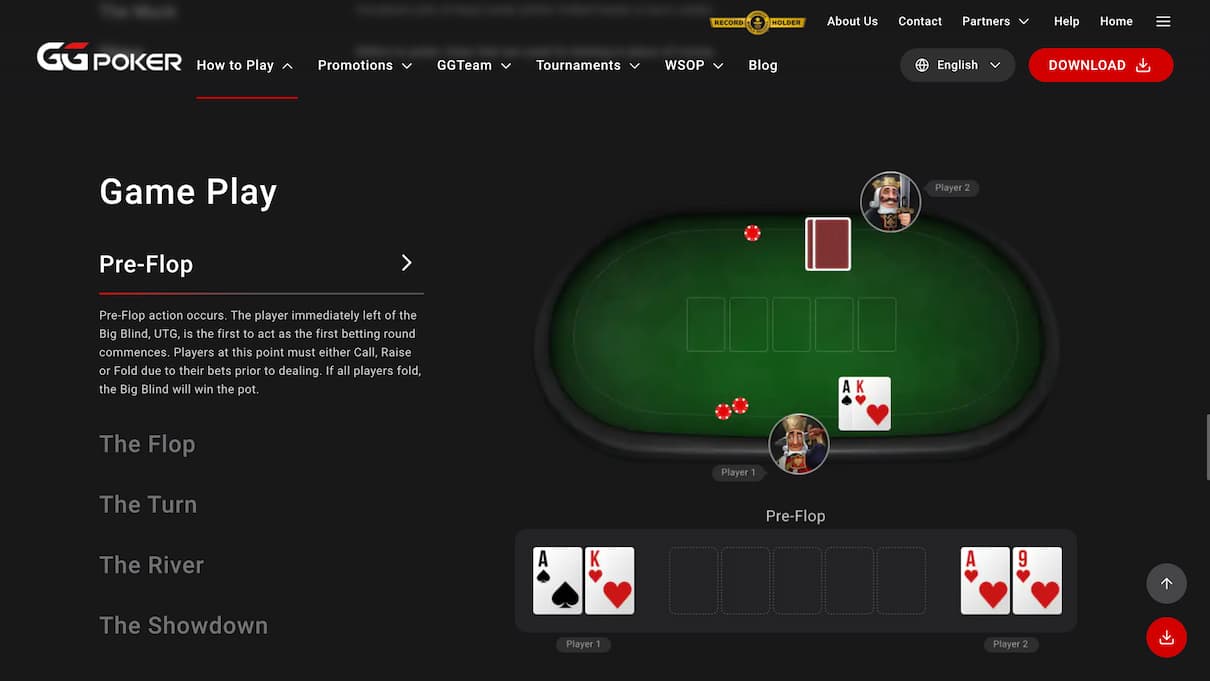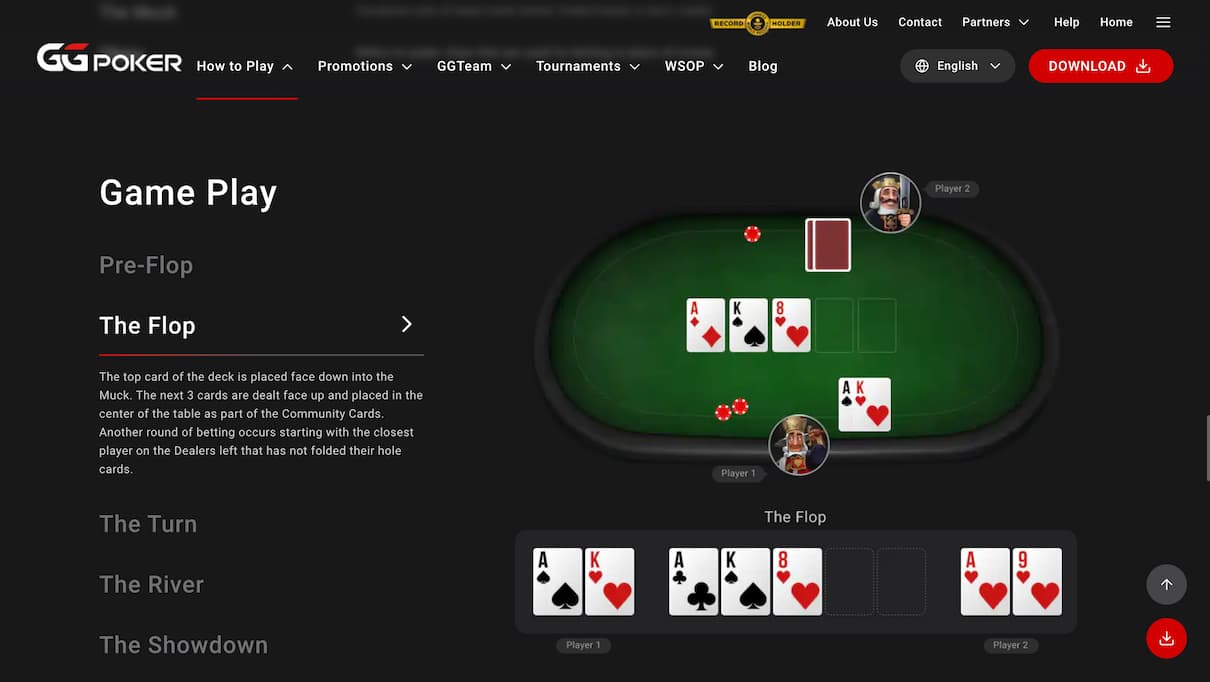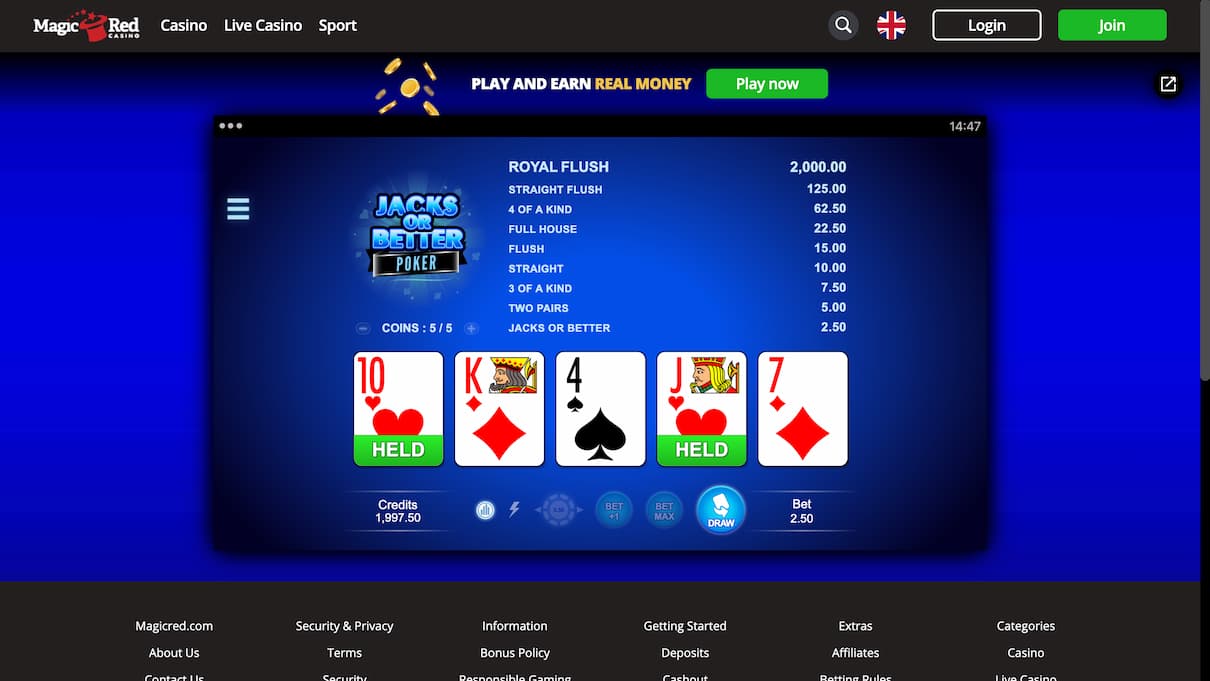Online Poker Strategy Guide – Poker Tips & Strategy Basics
Poker is a game of skill, patience, and, most importantly, strategy. While luck may play a role in the short term, a solid understanding of poker strategy can help you win more often in the long run. From Texas Hold’em to Pai Gow we’ve explained successful strategies you can use as a beginner or advanced player.
Using a suitable online poker strategy cannot guarantee a win but can significantly reduce mistakes that cause you to lose money. It can also make you more proficient by understanding how players may behave and how you can take advantage of particular situations during cash games or tournaments.
Understanding the Basics of Poker Strategy
Every poker strategy begins with the fundamentals. It’s important to start by understanding hand rankings, pot odds, and positions.
- Poker Hand Rankings: You cannot play poker effectively if you are unfamiliar with the applicable hand rankings. These outline and rank the strength of every eligible hand and may be used to determine the winner during a showdown.
- Table Position: If you are playing multiplayer games, such as Texas Hold’em, your position at the table should be significant in your best poker strategy. If you’re sitting in a late position, you can make better decisions. If you’re early, it’s better to be more cautious.
- Pot Odds and Equity: In multiplayer games, including Omaha Poker, calculate whether the pot odds justify the call. For example, if the pot offers £10 and you need to call £2, the odds are favourable if your odds of winning are above 20%.
Basic Poker Strategy for Texas Hold’em and Omaha
Texas Hold’em and Omaha are the two most popular multiplayer variants played online in the UK and the rest of the world. Unlike casino-style games where you’re playing against the house, these games pit players against each other. This creates the best opportunity to use poker betting strategy and psychology to beat your opponents.
Pre-Flop Poker Strategy
A pre-flop poker strategy is very important in setting the tone of the hand. Pre-flop is one of the poker terms used to describe the betting round between when players receive their hole cards and the dealer deals the first three community cards.
According to Texas Hold’em poker strategy, during the pre-flop, it’s a good idea to play aggressively with strong hands like Ace-King or pocket pairs. Avoid marginal hands, especially from early positions.
Omaha poker strategy for starting hands is slightly different, given that each player holds four hole cards. Starting hand selection is more complex, so you should focus on coordinated hands like double-suited connectors, such as 10-Jack-Queen-King.
You can use the following pre-flop poker strategy chart as a guide to help you take the best action based on your position at the table.
| Position | Hands to Play | Recommended Action |
| Early | A-A, K-K, Q-Q, A-K, A-Q, J-J | Raise or fold; avoid limping |
| Middle | A-A, K-K, Q-Q, A-K, A-Q, J-J, 10-10, 9-9, K-Q, A-J | Raise or call depending on position; cautious aggression |
| Late | All from Early and Middle, plus suited connectors (10-9s, 9-8s), low pairs (7-7, 6-6), weaker Ax suited | Raise wider or call; steal blinds with marginal hands |

Helpful Tip: Weaker suited Ax refers to hands where the Ace is paired with a lower card of the same suit, typically ranging from Ace-2 suited (A♠-2♠) to Ace-9 suited (A♦-9♦). These hands are considered “weaker” because the kicker (the second card) is low, reducing the overall strength of the hand.
Post-Flop Poker Strategy
Your position relative to the dealer can make or break your hand. A strong poker position strategy can help you make the most of your situational advantage within the rules of Texas Hold’em, Omaha, or any other variant featuring this stage.
Imagine you hold an Ace-Jack on a flop of Ace-8-3. In a late position, you can gauge your opponents’ strength based on their actions. A continuation bet might secure the pot if the remaining players show weakness.

GTO and Heads Up Poker Strategy
You need a heads up poker strategy when you’re playing one-on-one. In such a format, bluffing becomes a powerful tool. For example, turning a missed flush draw into a bluff on the river can force your opponent to fold.
You should also be ready to tighten up against aggressive opponents and exploit passive ones by betting more often.
GTO poker strategy is somewhat different as your focus should be on balancing your range to prevent exploitation. For example, when bluffing, you should ensure that your value-to-bluff ratio aligns with pot odds.
Poker Cash Game Strategy for Beginners
In poker cash games, the ability to rebuy lets you take a more patient and calculated approach. Success here depends mainly on disciplined decision-making. It’s also important to exploit positional advantages and leverage small edges over time.
For example, let’s imagine that in a £1/£2 game, you hold pocket Queens and the flop comes Queen-5-2. Rather than betting aggressively, you could check to trap opponents into committing more chips. Slow-playing monster hands is an effective poker cash game strategy to win money whilst playing fewer hands.
Using Poker Tournament Strategy to Win
When you’re playing in a tournament at one of the UK’s best online poker sites, your betting system will require adjustment as blinds increase and stack sizes dwindle. Poker tournament strategy, including Multi-Table Tournament or MTT poker strategy, caters to these unique challenges.
- Early Stage: Play conservatively and avoid high-risk moves. Accumulate chips with premium hands.
- Middle Stage: Identify weaker players to exploit. Stealing blinds at this stage in the tournament becomes vital.
- Final Stage: Adopt a short deck poker strategy if your stack is low, focusing on push-or-fold scenarios.
Helpful Tip: Using a short-deck poker strategy in the final stages of a regular-deck tournament is essential due to the similarities in dynamics, such as aggressive play and short-handed situations. High-card hands and broadway combinations gain increased value as blinds rise and stacks shrink, mirroring short deck priorities. This approach allows you to maximise equity and adapt to the fast-paced, high-pressure environment of tournament endgame play.
Poker Strategy Chart
From tournament poker strategy to playing your first cash game, the following chart can help you play your best hands time and time again.
| Scenario | Hands to Play | Recommended Action |
| Early Position | A-A, K-K, Q-Q, A-K, A-Q, J-J, 10-10 | Play tight and aggressively; avoid speculative calls |
| Middle Position | All Early Position hands plus 9-9, 8-8, A-J, K-Q, suited connectors like 10-9 | Expand your range slightly; look to isolate weaker players |
| Late Position | All Middle Position hands plus weaker suited Ax, low pairs (7-7, 6-6), and suited connectors like 8-7 | Steal blinds aggressively with a wider range of hands |
| Blind Defence | Broadway cards (A-K, A-Q, and A-J), suited connectors, mid-pairs (7-7, 6-6) against frequent blind stealers | Defend actively against late-position raises; re-raise with premium hands |
| Short-Stack Play in Tournaments | Strong hands (10-10+, A-Q+, suited broadway) for all-ins or re-steals | Adopt a push-or-fold strategy to maximise fold equity. |
While the poker basic strategy chart provides a strong foundation for both formats, always adapt to your stack size, table dynamics, and opponents’ tendencies. You can use this chart when playing Hold’em, Omaha, and similar variants.
Specific Strategies for Popular Poker Variants
No matter which variant you use to learn how to play poker, you’ll probably be eager to explore others to develop your skills. Since rules and gameplay can vary significantly, we’ve listed the best poker strategy to use with a specific variant.
Texas Hold’em Poker Strategy
The poker basic strategy for this variant starts by learning the rules of Texas Hold’em and winning hand rankings. Generally, it’s best to play premium hands aggressively, especially in early positions, to build the pot. Use your position to apply pressure on opponents and adjust your strategy based on table dynamics and player tendencies.
Omaha Poker Strategy
Just like with Texas Hold’em, you should first become confident with Omaha Poker rules. Then, focus on cards that can make the nuts, such as double-suited connectors. Avoid playing weak, uncoordinated hands and be cautious of draws since equities run closer.
Helpful Tip: Make the nuts is a poker term which refers to the strongest possible hand given the current community cards. Double-suited connectors are hands with two pairs of suited cards that are close in rank and connected, such as 10♠,9♠,8♦, and 7♦. Equity, meanwhile, defines the chance of winning a hand at the showdown.
3 Card Poker Strategy
3 Card Poker online resembles blackjack in that you’re playing against the dealer. As a result, the best Three Card Poker strategy is to stick to the Pair Plus bet for a lower house edge. Fold hands weaker than Queen-6-4 and balance your bets to avoid significant losses from a single hand.

Helpful Tip: Tri Card Poker and similar casino-style variants don’t have any room for bluffing or advanced strategies. However, you can use casino bonuses to enhance the value of your bankroll, allowing you to take more risks or play more games without spending more.
Pai Gow Poker Strategy
Pai Gow Poker is a casino game where you need to create two hands – a five-card hand and a two-card hand – from seven dealt cards. The best Pai Gow Poker strategy to use at UK online casinos is to set a strong two-card hand without weakening your five-card hand. Prioritise straights and flushes for the five-card hand and avoid breaking pairs unless absolutely necessary.
Video Poker Strategy
Online video poker is an electronic version of poker where creating a winning hand guarantees a payout. In such a format, holding high pairs over chasing draws is a better video poker strategy for positive results in the medium term. Depending on the variant you’re playing, you may even want to consult a video poker strategy chart for the best possible actions.

Skills for Using Poker Strategy for Beginners
If you’re new to poker or are playing a new variant for the first time, keeping these tips in mind will help you implement the appropriate poker strategy effectively.
- Patience: Identify weak starting hands to avoid playing too many hands and practise bankroll management to support yourself when you get stronger hands.
- Observation: Whilst playing poker, try and keep note of player behaviours and showdown hands to identify frequent bluffers and overly cautious opponents.
- Practice: Use free games to build experience wherever possible and play low-stakes games, such as ones with small blinds of £0.01 and big blinds of £0.02.
- Manage: Set a budget before you start playing to gamble responsibly and stop playing as soon as you’ve run out of money.
- Learn: It takes time to learn how to properly implement a winning poker strategy, so don’t expect instant results and learn from every win as well as every loss.
Bluffing and Other Poker Strategies for Advanced Players
Once you have mastered the beginner poker strategy, you’ll want to explore other ways to try and beat opponents. The following are five examples where the right strategy can make the difference between a win and a loss.
Bluffing in a Poker Cash Game
You hold 7-8 suited on a board of 5-6-10-2. Bet aggressively to force folds or build the pot. Even if called, your straight-outs and backdoor flush potential provide equity.
Navigation Short Stacks in Tournaments
With 12 big blinds left, adopt a push-or-fold strategy. Go all-in with medium pairs (example 7-7) or strong Aces. Avoid speculative calls unless the odds are overwhelmingly in your favour.
Slow Playing a Monster Hand
You hold pocket Queens, and the flop is Q-5-2 rainbow. Check or call to trap opponents into betting. On the turn, re-evaluate based on draws or betting behaviour to extract maximum value.
Helpful Tip: Rainbow in this setting refers to having cards of different suits, such as Q♥, 5♠, and 2♦. This term indicates that no flush draws are possible from the flop alone, as there are no two cards of the same suit.
Stealing Blinds in Late Position
You’re on the dealer button, and everyone has folded to you. Raise with marginal hands like K-8 suited or J-10 off-suit. Tight opponents in the blinds often fold, allowing you to pick up chips without a fight.
Semi-Bluffing with a Draw
You hold 9♠-10♠ on a board of 8♦-7♠-2♣. Bet aggressively to represent strength while drawing to a straight or flush. If called, the turn provides additional opportunities to hit your draw or bluff further.
Playing Against Aggressive Opponents
Let’s imagine you’re facing a hyper-aggressive player who frequently bets or raises. The best poker strategy would be tightening your range and trapping with strong hands. Use their aggression against them by slow-playing to induce bluffs and bigger pots.
Staying Safe While Playing Poker Online
In addition to applying an online poker strategy, follow these top tips to enjoy a safe gaming experience.
- Choose reputable poker rooms: Play only on secure, licensed platforms with strong player reviews that are regulated and overseen by the UK Gambling Commission, or other reputable authorities.
- Use secure connections: Always play over a private, secure internet connection. Avoid public Wifi to protect your personal and financial information and consider using a VPN to connect using a safe connection.
- Protect your online poker room account: Use strong, unique passwords for your accounts and enable two-factor authentication (2FA) for added security. Never share your passwords with anyone and change them often.
- Avoid sharing personal details: Never share sensitive information like your account or banking credentials. Also be careful not to divulge personal details, including your location, through your poker room alias.
- Set responsible limits: Use site tools to set deposit and loss limits to ensure you’re playing responsibly and safeguarding your finances. Stop playing if you feel tired or if you’re not able to keep emotions out of the decision-making process.
Other Helpful Poker Playing Guides
Now that you have a better understanding of poker strategy, check out our other popular poker guides.
- How to play poker – Learn the basics of playing online poker, including the differences between popular variants.
- Texas Hold’em rules – Find out everything you need to know about playing Texas Hold’em online.
- Poker terms – Poker terminology for beginners and seasoned players.
- 5 Card Poker rules – Learn the rules and key nuanches of 5 Card Draw and 5 Card Stud.
- How to play 3 Card Poker – Explore a set of unique strategies for this casino-style poker variant.
- Omaha Poker rules – Develop your skills with specific rules and strategies for Omaha Poker.
- Poker Rake – Knowing the cost of each hand can give you an edge – discover how rake affects your game.
Conclusion
The best poker strategy is adaptable, blending theoretical knowledge with real-world adjustments. Whether you’re a beginner learning the basics or an advanced player exploring GTO poker strategy, the key to success is continual improvement. Practice these strategies across variants, and you’ll see your skills and confidence grow.
FAQs
What is the best poker strategy for beginners?
What’s a winning heads up poker strategy?
Is there an online poker tournament strategy for new players?
How is three card poker strategy different from Texas Hold’em strategy?
What is the 80/20 rule in poker?
Resources
- https://www.gamblingcommission.gov.uk/about-us/what-we-do
- https://www.ncsc.gov.uk/collection/device-security-guidance/infrastructure/virtual-private-networks
- https://www.gambleaware.org/advice/for-your-gambling/advice-to-consider-if-you-re-gambling/
